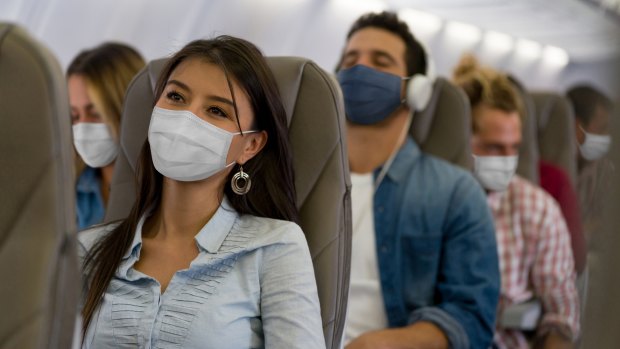This was published 2 years ago
Masks rules on flights: The wrong type of mask could see you banned from your flight
By Michael Gebicki

Make sure you have the right type of mask for your flight.Credit: iStock
"You can't board the flight with those masks". That's what an American couple were told as they were about to hop aboard their midsummer flight to Munich at Rome's Fiumicino Airport. Seems their surgical masks were frowned upon in the state of Bavaria.
Only FFP2 masks would do, they were told, and that applies to passengers on incoming flights. Panic and dismay spread across their faces, but an airport vending machine solved the problem and all ended happily, but it was a near miss.
As if travel wasn't already enough of a minefield. Different vaccination requirements, pre-flight PCR tests, quarantine snags, sudden lockdowns and now this. Turns out that the requirements for mask wearing in Europe will make your head spin.
Some jurisdictions require masks inside, some outside, some in venues with more than 100 people and some not while others demand a certain type of mask – such as Bavaria. In nearby Austria, FFP2 masks are required on public transport, in cable cars, supermarkets, chemists, petrol stations and banks. So just exactly what is an FFP2 mask?
FFP2/N95/KN95/P2 masks
All these masks are similar. All are made from multiple layers of synthetic material, but they're certified according to different national standards. The FFP standard is the EU certification while N95 is the US standard and KN95 is the Chinese equivalent.
N95 masks are so named because they can filter at least 95 per cent of particles as small as 0.3 micrometre, and a micrometre is one-millionth of a metre. COVID-19 is primarily spread by larger respiratory droplets, at least 5 micrometres.
According to some US studies, N95 masks are slightly more breathable and therefore more comfortable than KN95 masks, but note that most N95 masks are also made in China. In a study conducted by 3M's Personal Safety Division, the filtration performance of FFP2 masks was found to be at least 94 per cent. The same study found FFP2 masks have a slightly better flow rate than N95 masks, which makes beathing easier, while the inward leakage, as measured on subjects performing exercises, is the same for both masks.
Masks in this category are commonly sold as P2 masks in Australia. Some have a valve which makes breathing easier, but the protection only works in one direction. The mask will protect the wearer, but the valve allows virus particles to escape. The US Centers for Disease Control and Prevention recommends against such masks and they're forbidden on US airlines, which require masks to be worn at all times on board.
These masks are only at maximum effectiveness if they fit tight. Facial hair will increase the leak factor. Makes sense, doesn't it? Just like a standard dive mask, or my swim goggles when my eyebrows bush up, bearded blokes have a problem.
Surgical masks
They might look flimsy but those blue and white surgical masks do a great job. After all, they're what surgeons commonly wear in the operating theatre. According to the open access medical journal published by the American Medical Association, "Although surgical masks have lower filtration efficiency than N95 respirators, observational studies have shown no significant benefit of N95 masks over surgical masks for prevention of severe acute respiratory syndrome coronavirus."
The US National Center for Biotechnology Information begs to differ, saying, "On average, the protection factors of FFP respirators are 12 to 16 times greater than those of surgical masks, although the fit to the wearer;s face is the most important factor in their effectivity." Australia's Department of Health says a surgical mask can be used for up to four hours as long as it's not moist or damaged.
FFP3/N99/EN149/P3 masks
The "99" that follows the "N" tells you that these masks filter out at least 99 per cent of virus particles. These are the pinnacle of disposable face mask technology, offering protection against even highly infectious pathogens and for that reason they're recommended for nursing staff working with COVID-19 patients. To be completely effective they need to be fitted tight and that's best left to an expert.
There's a downside. They're uncomfortable when worn for long periods. Nursing staff have experienced skin damage and pressure ulcers. For travellers there is no real reason to choose these over the N95 class of masks.
Masks, PCR testing, lockdowns – is travel all too hard?
Nope. What's the alternative – stay on the couch and watch the adventures of others? Travel has become the unknown and the merchants of fear are singing songs of doom but I'm not listening. What if Magellan, Cook or the first human to set foot outside Africa had been frightened of the unknown? As for masks, I might add a pack of N95/P2 respirators to my travel kit just in case – $2-4 per mask is the going rate – but I'm off.
See also: International travel is back: Everything you need to know
Sign up for the Traveller newsletter
The latest travel news, tips and inspiration delivered to your inbox. Sign up now.